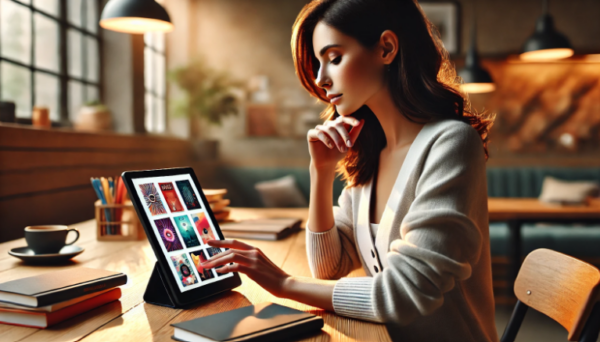In the fierce world of publishing, your nonfiction book cover has one job: to bring that unmistakable “pick me energy”, practically shouting, “I’m the one!” Imagine walking into a bookstore, or endlessly scrolling online, surrounded by thousands of covers, each one jostling for attention. How do you choose? Turns out, nearly 79% of readers make their first judgment call on looks alone (we’re all a little guilty). And for nonfiction, the stakes are even higher—readers are looking for authority and insight in an instant, a cover that says, “I know my stuff,” with zero hesitation.
It’s like speed dating for books: your cover has a single chance to catch someone’s eye, give off the right vibe, and get that second look. So how do you create a cover that’s not just visually striking, but dripping with confidence and expertise? Let’s dive into the art and psychology of nonfiction cover design, where every visual cue works to sell your book’s message, theme, and tone—all before a page is turned.
Your Book’s Message and Audience
Your cover design should reflect the “why” behind your book and resonate with your target audience. If you’re writing a business book, aim for visuals that project professionalism and expertise; if it’s a self-help guide, go for colors and imagery that exude warmth and approachability. Knowing your target reader allows you to make decisions that resonate on a personal level.
Your Publishing Journey Awaits – Start NowTake a tip from bestsellers: Tim Ferriss’s Tools of Titans uses minimalistic design to underscore the book’s simplicity in delivering powerful insights. Similarly, the choice of vibrant reds on Malcolm Gladwell’s covers immediately suggests energy and curiosity, enticing readers who crave thought-provoking ideas. By aligning your cover with your book’s essence, you’re inviting the right audience in.
Spines Tip: Need help figuring out the right visuals for your book? Spines combines AI with human expertise to create covers that resonate with your book’s genre and audience, making that all-important first impression count.
Crafting a Compelling Title
A compelling title is the cornerstone of a successful non-fiction book cover. It’s the first thing potential readers will notice, and it needs to make a strong impression. A well-crafted title should be clear, concise, and accurately convey the book’s subject matter. Here are some tips to help you create a title that stands out:
- Use Keywords: Incorporate keywords that accurately describe your book’s content. This not only helps with searchability but also immediately informs readers about the book’s focus.
- Keep It Short: A concise title is easier to remember and more impactful. Aim for brevity without sacrificing clarity.
- Avoid Jargon: Steer clear of technical terms or jargon that might confuse readers. Your title should be accessible to a broad audience.
- Action Words: Use verbs or action words to create a sense of excitement or urgency. This can make your title more dynamic and engaging.
- Memorability: Ensure your title is easy to remember and pronounce. A catchy title can stick in a reader’s mind long after they’ve seen it.
Consider the title Sapiens: A Brief History of Humankind by Yuval Noah Harari. It’s short, descriptive, and intriguing, making it a perfect example of a compelling non-fiction book title. Remember, your title is your book’s first impression—make it count.
Non-Fiction Book Cover Design: Key Visual Elements
So what goes into a nonfiction book cover design that stops readers in their tracks? Let’s explore the core elements:
- Central Image: Your cover’s focal point should tell a story. Whether it’s an abstract graphic or a literal representation, a well-chosen image can convey the essence of your topic. Consider Brené Brown’s Dare to Lead, where a bold brushstroke captures the book’s daring and authentic approach.
- Bold Typography: In a world of scrolls and swipes, your title should be readable in an instant. Using large, bold fonts like sans-serif styles can make your title memorable and eye-catching. And yes, avoid Comic Sans—it’s the design world’s version of a faux pas.
- Color Palette: Colors carry psychology. Red often suggests energy and urgency, while blue conveys calm and reliability. Choose your colors thoughtfully to reflect the mood of your book.
- White Space: Don’t be afraid to leave some breathing room. White space, or negative space, helps draw attention to the main elements without overwhelming the viewer. The minimalist approach can also evoke a sense of sophistication—just ask any best-selling business book.
- Supporting Graphics: Icons or subtle graphic elements can add personality to your cover without clutter. A small compass icon on a travel memoir or a target symbol on a goal-setting book can reinforce the theme in a subtle, effective way.
Visual Hierarchy: Guiding the Reader’s Eye
Visual hierarchy is the art of controlling what viewers see first, second, and third. Your title should be the main attraction, followed by the subtitle or a key graphic, and finally the author’s name. Look at Daniel Kahneman’s Thinking, Fast and Slow—the title commands attention, while the faint line drawing of a pencil reinforces the book’s scientific yet accessible nature.
Establishing a visual hierarchy is crucial in a nonfiction book cover, as it emphasizes the important elements and creates a natural flow for readers’ eyes. Remember, an overwhelmed reader is a potential reader lost. Aim for clarity, not chaos.
Capturing Reader Attention: Using Bold Fonts, Colors, and Visual Balance
Let’s face it: nonfiction book covers aren’t known for their loud, colorful designs, but a touch of contrast can work wonders. Think about bold fonts, high contrast color schemes, and strong visual elements that immediately communicate the tone and subject of your book. Bold typography against a simple background can make even complex subjects feel accessible.
Your Publishing Journey Awaits – Start NowOne example? How to Win Friends and Influence People. Its vintage red and gold palette combined with solid typography still stands out on shelves nearly a century later. The trick is to balance attention-grabbing elements with a level of restraint that respects your reader’s intelligence.
Spines Tip: With Spines, you can experiment with bold fonts, vibrant colors, and various layout options, ensuring your cover is memorable without losing that professional touch.*
Matching Visual Style with Genre: Business, Self-Help, and More
Each genre of nonfiction books comes with its own visual expectations. Business books, for example, usually opt for a clean, straightforward look with minimal color and high readability. Self-help books, on the other hand, often feature warm colors, inviting images, and approachable typography. Your choice of visuals should reflect these unspoken “rules” to make your book instantly recognizable to your target readers.
If you’re unsure about these conventions, try browsing through bestsellers in your genre. Noticing a trend? That’s no coincidence. Readers have subconscious expectations, and meeting these can be the key to connecting with your audience.
Reviews and Endorsements
In the world of non-fiction, reviews and endorsements can be a game-changer. They provide social proof and credibility, helping to build trust with potential readers. Here’s how to effectively use reviews and endorsements on your non-fiction book cover:
- Expert Quotes: Include quotes from well-known experts or thought leaders in your field. Their endorsement can lend significant weight to your book’s credibility.
- Reputable Sources: Use reviews from reputable publications or websites. A positive review from a respected source can be very persuasive.
- Satisfied Readers: Don’t underestimate the power of endorsements from satisfied readers or customers. Real-world testimonials can resonate strongly with potential readers.
- Concise and Impactful: Keep reviews and endorsements concise and to the point. Highlight the most compelling parts to make a strong impact.
- Highlight Benefits: Use endorsements to underscore the key benefits and features of your book. This can help potential readers quickly grasp what they’ll gain from reading it.
For instance, the cover of The Power of Habit by Charles Duhigg features endorsements from notable figures and publications, adding to its appeal and credibility. By strategically placing reviews and endorsements, you can significantly enhance your book’s attractiveness and trustworthiness.
Book Summary and Presentation
A well-crafted book summary is essential for providing potential readers with a clear understanding of your book’s content and benefits. Here are some tips for creating an effective book summary and presentation:
- Be Concise: Keep your summary short and to the point. Potential readers should be able to grasp the essence of your book quickly.
- Clear Language: Use simple, clear language that’s easy to understand. Avoid complex sentences and jargon.
- Highlight Key Benefits: Focus on the main benefits and features of your book. What will readers gain from it? Make this clear.
- Readable Format: Use bullet points or short paragraphs to make the summary easy to read. A well-organized summary is more likely to hold a reader’s attention.
- Readable Font: Choose a clear, easy-to-read font for your summary. This ensures that your text is accessible to all readers.
Take a look at the back cover of Thinking, Fast and Slow by Daniel Kahneman. The summary is concise, highlights the book’s key insights, and is presented in a readable format. A well-crafted summary can entice potential readers and provide them with a clear understanding of what your book offers.
By following these tips, you can create a non-fiction book cover that not only captures attention but also effectively communicates the value of your book to potential readers.
Print vs. Digital Covers: Adapting for Different Formats
Designing for digital is a different ball game from designing for print. Digital covers are often seen in thumbnail sizes, meaning bold fonts and simplified graphics can go a long way. Print, on the other hand, allows for more detail—think spine design, dust jackets, and paper quality.
A digital cover may need to “pop” more due to the small screen sizes, while a printed cover can take advantage of texture and finer details. As you design, keep in mind how each format impacts your book’s physical and digital appeal.
Practical Tips for Self-Publishing Authors
Self-publishing authors may feel intimidated by the design process, but fear not—platforms like Spines offer tools to make cover creation easier. Here are some tips for tackling it yourself:
- Start with Templates: Templates save time and prevent common design mistakes.
- Invest in High-Quality Images: Blurry or low-quality images will sink your book’s credibility faster than you can say “Pixlr.”
- Choose Consistent Fonts: Avoid mismatched fonts across multiple books; instead, create a cohesive “brand” for your works.
For first-time self-publishers, cover design can feel overwhelming, but the right tools make it manageable. Spines’ AI-driven cover designer provides tailored suggestions, allowing you to focus on refining rather than reinventing your book’s cover.
Learning from Success: Non-Fiction Covers That Work
Examples speak volumes, so let’s look at a few that nailed it:
– Atomic Habits by James Clear: Clean, modern, and deceptively simple, the dotted pattern subtly hints at change through accumulation, mirroring the book’s message.
– Becoming by Michelle Obama: A warm, inviting image of the author paired with bold yet soft typography that makes the cover feel approachable and personal.
Each of these covers is both a design triumph and a marketing tool, setting the tone for the reader’s journey. They highlight the power of visual elements to create an instant connection.
Make Your Book Cover a Gateway, Not a Gatekeeper
Designing a non-fiction book cover isn’t about creating a work of art for art’s sake—it’s about crafting an effective marketing tool that makes potential readers stop, look, and say, “Tell me more.” When done right, a cover goes beyond aesthetics to become a powerful element of your book’s identity, a doorway into your content.
For authors looking to simplify their publishing journey, Spines provides an ideal solution. With an AI-driven platform and expert support, Spines helps bring your vision to life, whether it’s a sleek business book or a vibrant self-help guide. Embrace the power of visuals and make your cover a true reflection of your book’s impact.
Ready to bring your non-fiction vision to life? At Spines we offer a free cover design tool, so you can best design your book cover without going through the hassle of finding a designer or paying large sums of money. Sign up with Spines and let our tools and team help you create a book cover that speaks volumes.
Your Publishing Journey Awaits – Start Now







